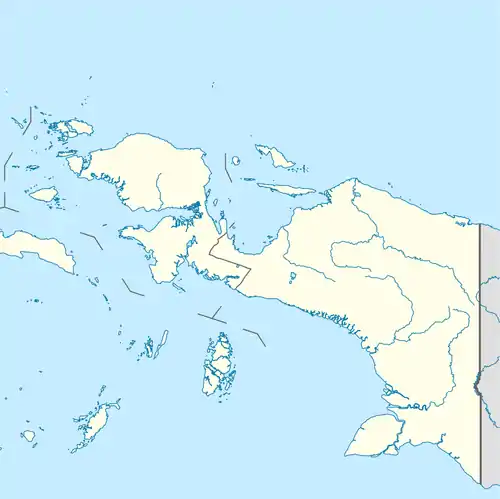Bomberai Peninsula
Bomberai Peninsula (Indonesian: Semenanjung Bomberai) is located in the Western New Guinea region, opposite to and to the south of the Bird's Head Peninsula. To the west lies the Sebakor Bay and to the south Kamrau Bay. Sabuda island lies off the western tip of the peninsula, and is separated from the mainland by Berau and Bintuni straits.
| Native name: Semenanjung Bomberai | |
|---|---|
 Bomberai Peninsula | |
| Geography | |
| Coordinates | 03°09′19.15″S 133°10′15.6″E |
| Adjacent bodies of water | Seram Sea Bintuni Bay |
| Administration | |
| Province | |
| Largest settlement | Fakfak |
Geography
The entire peninsula is covered by a dense tropical rainforest, and most of the peninsula consists of a marshy plain. Together with the Bird's Head Peninsula and offshore islands, the Bomberai Peninsula forms the Indonesian province of West Papua (Indonesian: Papua Barat). The western part of the peninsula is occupied by Fakfak, the north belongs to Teluk Bintuni Regency and the southeast to Kaimana. It is a wide peninsula that opens to the sea of Ceram, forming a wide bay, the bay of Sebakor, defined by two small peninsulas:
- to the northwest, the peninsula of Onin or Fakfak, with the name of the city of Fakfak, the main town and port of the region. It is covered by a mountain range which reaches 1619 m (5312 ft) altitude. Due to the facilities offered by the city Fakfak, this part of the Bomberai peninsula is the most visited.[1]
- to the southeast, the peninsula formed by the Kumafa mountains, whose south coast is bathed by the sea of Arafura. It is a region little explored and almost unknown.
To the north lie the Berau Bay and Bintuni Bay, which separate the Bomberai Peninsula from the Bird's Head peninsula. Off the north coast are located the islands Amutu Besar, Asap, Arguni and Ogar. Opposite is the island of Panjang in Tamaruni Bay.[2][3]
Further south are the island of Samai and Sebakor Bay, which is protected from the offshore island of Karas to the Tamaruni Bay. Southeast beyond the Nautilus Strait (Indonesian: Selat Nautilus) is the island of Adi.[4] In the east, Kamrau Bay separates the peninsula from the rest of New Guinea. At its northernmost point lies the island of Freterenusu in the bay. Only narrow land bridges connect the Bomberai peninsula with the neighboring land masses.
History
There were trading relationships that formed based on birds of paradise feathers with 7th century Sriwijaya and the surrounding islands.
There was a mention of “Wanin” in 14th century Nagarakretagama manuscript as a region/tributary of Majapahit. Scholars tends to attribute this to Onin Peninsula, which if true represent the earliest mention of native name of papua regions.
The first sighting by Europeans of this zone was in 1606, in the Spanish expedition commanded by Luís Vaz de Torres.
Languages
There are several Central–Eastern Malayo-Polynesian languages spoken on the Bomberai Peninsula, including Uruangnirin, Onin, Sekar, Arguni, Bedoanas, Erokwanas, and Irarutu.[5]
Language isolates spoken in the Bomberai Peninsula are Mor and Tanah Merah.[6]
The West Bomberai languages Baham and Iha are also spoken on the peninsula, as well as the Asmat-Kamoro languages Buruwai and Kamberau, and the South Bird's Head language Kemberano.[6] The Timor–Alor–Pantar languages may possibly have lexical links with the West Bomberai languages, although this proposal is not without controversy.[7][8]
Karas, a West Bomberai language, is spoken on Karas Island, a small island located just off the western coast of the Bomberai Peninsula.
Fauna
Twenty-four endemic species of rainbow fish (Melanotaenia) live on the Bird's Head Peninsula, Bomberai Peninsula and offshore islands. Many live in the karst areas, including the Harlequin Rainbow Fish (Melanotaenia boesemani).[9]
Fauna of the Fakfak Mountains includes the black-eared catbird and Oninia senglaubi, a member of the family of the narrow-mouthed frogs (Microhylidae).[10]
References
- Onin Peninsula (Fakfak), The Papua Insects Foundation.
- Der große Weltatlas, Millenium House, 2009, ISBN 978-1-921209-31-4.
- Stephen Backshall: The Rough Guide to Indonesia, S.1022, 2003, ISBN 978-1-858289-91-5.
- A directory for the navigation of the Indian Archipelago, China, and Japan, from the straits of Malacca and Sunda, and the passages east of Java. To Canton, Shanghai, the Yellow Sea, and Japan, with descriptions of the winds, monsoons, and currents, and general instructions for the various channels, harbours, etc. By Alexander George Findlay. Published: London, R. H. Laurie, 1878.
- Hammarström, Harald; Forkel, Robert; Haspelmath, Martin, eds. (2019). "Glottolog". 4.0. Jena: Max Planck Institute for the Science of Human History.
- Holton, Gary; Klamer, Marian (2018). "The Papuan languages of East Nusantara and the Bird's Head". In Palmer, Bill (ed.). The Languages and Linguistics of the New Guinea Area: A Comprehensive Guide. The World of Linguistics. 4. Berlin: De Gruyter Mouton. pp. 569–640. ISBN 978-3-11-028642-7.
- "Andrew McWilliam: Austronesians in linguistic disguise: Fataluku cultural fusion in East Timor" (PDF). Archived from the original (PDF) on 2014-11-07. Retrieved 2018-08-16.
- Holton, Gary; Robinson, Laura C. (2017), "The linguistic position of the Timor-Alor-Pantar languages", in Klamer, Marian (ed.), Alor Pantar languages: History and Typology Second Edition, Berlin: Language Sciences Press, pp. 147–190, doi:10.5281/zenodo.437098
- Nugraha, M.F.I., Kadarusman, Hubert, N., Avarre, J.C., Hadiaty, R.K., Slembrouck, J., Carman, O., Sudarto, Ogistira, R. & Pouyaud L. (2015): Eight new species of Rainbowfishes (Melanotaeniidae) from the Birds Head Region, West Papua, Indonesia. Cybium, 39 (2): 99-130.
- Darrel R. Frost: Oninia senglaubi. Amphibian Species of the World, an Online Reference, Version 6.0. American Museum of Natural History, New York 1998–2015, abgerufen am 21. Dezember 2015